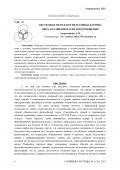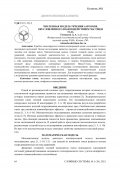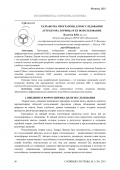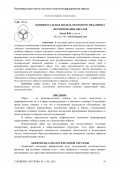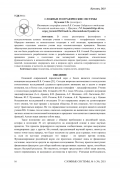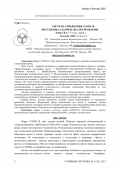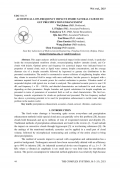Показана необходимость и возможность построения целостной картины мира в условиях продолжающейся дифференциации и специализации современной науки, значительно уступая сопутствующему процессу интеграции. Построение единой картины мира производится с помощью системно структурной методологии, главным методом которой являются уровни структурной организации материи, обеспечивающие последовательный переход как по цепочке с одного уровня на другой от элементарных частиц до максимальных космических объектов, включая биологические и социальные системы и обратно, обеспечивая закономерную последовательность перехода по уровням структурной организации материи. Все это полезно для любого научного исследования на начальном и конечном этапе, а также, в системе просвещения.
В работе моделируются течения неоднородной среды, состоящей из газа и дисперсных включений. Целью исследования являются аэрозоли – взвешенные в газе твердые частицы или жидкие капли. Математическая модель течения сложной среды состоит из уравнений динамики несущей компоненты-газа и уравнений динамики дисперсной компоненты. Система уравнений, описывающая движение каждой компоненты смеси включает в себя уравнения непрерывности массы, импульса и энергии. Непрерывность импульса несущей фазы описывается одномерным уравнением Навье-Стокса. Межфазное взаимодействие определялось известными из литературы соотношениями. Динамика смеси моделировалась в одномерном приближении. Уравнения математической модели интегрировались явным конечно-разностным методом. Для подавления численных осцилляций к полученному решению применялась схема нелинейной коррекции сеточной функции.
Трёхмерное изображение решения системы обыкновенных дифференциальных уравнений (ОДУ), описывающих конвективный поток, представляет собой аттрактор Лоренца. Данная система уравнений является базовой детерминированной системой, с исследования которой началось развитие теории хаоса. Для получения характеристик этой сложной системы необходима разработка современного программного продукта, доступного и удобного в использовании.
Целью работы являлось создание программы для исследования аттрактора Лоренца на языке Python с использованием библиотек специальных команд. Особенное внимание уделено способам решения системы ОДУ разными численными методами и наглядности представляемых результатов.
Описаны блоки кода разработанной программы; с её помощью произведён расчёт аттрактора Лоренца при варьировании численных методов решения ОДУ и параметров системы. По результатам расчёта сделаны выводы.
В настоящей работе предлагается версия мозгового механизма возникновения и формирования перцептивного и психического образов. Начальным событием возникновения перцептивного образа является результат взаимодействия на релейных нейронах таламуса сенсорного хаотического импульсного потока и организованного в пачки импульсного потока, исходящего из ретикулярных структур. Последующий этап – это формирование метаустойчивого динамического объединения возбужденных колонок коры большого мозга. Рассматривается роль функционального объединения колонок коры и интрафузальной мышечной рецепции в активации распределённых систем мозга и формировании перцептивного образа. Этот образ рассматривается как метаустойчивое состояние синергичных процессов в нейро-мышечных структурах. Дается обоснование не воспринимаемости перцептивного образа. Предполагается, что основу психического образа составляют воспринимаемые эффекты ньютоновских сил, вызываемые сокращениями мышц. Обсуждаются свойства перцептивного и психического образов, их отличие и сопряженность. Роль психического образа во взаимодействии с образами сознания.
В статье рассмотрены философские и методологические аспекты эволюции учения о геосистемах – географических системах. Обращено внимание на нежелательные тенденции в этой эволюции, проявляющиеся в придании отдельным аспектам учения вида основополагающих принципов. Показана общенаучная диалектическая основа классического варианта учения о геосистемах, в том виде, как оно было разработано его основоположником – академиком В.Б. Сочавой. Подчеркивается несостоятельность разработанных позже и разрабатываемых в настоящий момент частных принципов учения о геосистемах как метанаучной парадигмы, относительная фундаментальность и жизнеспособность классических широко трактуемых, «несовершенных» понятий, позволяющих оперировать ими в широком круге аспектов географического (и не только) познания, в частности, на примере учения о геосистемах.
Вирус СOVID-19 унёс тысячи жизней. Породил мировой экономический и социальный кризис.
Цель статьи – привлечь внимание к управлению взаимодействием вируса и человека. Сформулированы следующие задачи. 1. Купирование (минимизация) активности вируса в организме человека. 2. Профилактика (минимизация) распространения вируса при максимизации экономического роста. 3. Использование сознания (динамических стереотипов) для формирования навыков защиты от вирусов, усиления иммунитета и использования вирусов с пользой для человека. 4. Постановка задачи сосуществования вируса (биосферы) и человека. Анализ этих задач позволил сформулировать варианты решений и представить на обсуждение механизмы реализации: базы врождённых и приобретённых навыков, методы самообучения и самоорганизации и практику сознательного созидания стереотипов. Некоторые из этих возможностей рассмотрены в этой статье.
Авторы разработали и успешно используют индивидуальную терапию на основе саморегуляции и центральной организации вегетативных функций. Исследовано формирование стереотипов и доминант в эксперименте на животных и в клинике при лечении.
Главный вывод: сегодня доминанта сознания людей акцентирована на социальных проблемах общества. Внутренней сфере практически нет места в сознании. Нужно переориентировать доминанту нашего сознания на решение задач внутренней сферы организма для сохранения баланса. В частности, во взаимодействии человека с СOVID-19.
Widespread introduction of mobile robotics in various spheres of human activity
makes the problem of mass disposal of expired, outdated and faulty robots topical. When disposing of
each type of mobile robots, it is necessary to take into account peculiarities of its design, composition
of on-board equipment and take into account environmental risks in case of destruction of the robot
structure with its fragments getting into the environment. Depending on the type and purpose of
robots, their disposal and recycling have significant features. This paper analyzes the problems
associated with the disposal of different types of autonomous mobile robots. The main sources of
environmental pollution present in the components of robots: electronic components, accumulator
batteries, constructional materials, connecting cables are considered. The environmental impact of
different types of mobile robots and the prevailing types of waste during their disposal are determined.
Widespread introduction of mobile robotics in various spheres of human activity
makes the problem of mass disposal of expired, outdated and faulty robots topical. When disposing of each type of mobile robots, it is necessary to take into account peculiarities of its design, composition of on-board equipment and take into account environmental risks in case of destruction of the robot structure with its fragments getting into the environment. Depending on the type and purpose of robots, their disposal and recycling have significant features. This paper analyzes the problems associated with the disposal of different types of autonomous mobile robots. The main sources of environmental pollution present in the components of robots: electronic components, accumulator batteries, constructional materials, connecting cables are considered. The environmental impact of different types of mobile robots and the prevailing types of waste during their disposal are determined.
Widespread introduction of mobile robotics in various spheres of human activity
makes the problem of mass disposal of expired, outdated and faulty robots topical. When disposing of each type of mobile robots, it is necessary to take into account peculiarities of its design, composition of on-board equipment and take into account environmental risks in case of destruction of the robot structure with its fragments getting into the environment. Depending on the type and purpose of robots, their disposal and recycling have significant features. This paper analyzes the problems associated with the disposal of different types of autonomous mobile robots. The main sources of environmental pollution present in the components of robots: electronic components, accumulator batteries, constructional materials, connecting cables are considered. The environmental impact of different types of mobile robots and the prevailing types of waste during their disposal are determined.
Widespread introduction of mobile robotics in various spheres of human activity
makes the problem of mass disposal of expired, outdated and faulty robots topical. When disposing of each type of mobile robots, it is necessary to take into account peculiarities of its design, composition of on-board equipment and take into account environmental risks in case of destruction of the robot structure with its fragments getting into the environment. Depending on the type and purpose of robots, their disposal and recycling have significant features. This paper analyzes the problems associated with the disposal of different types of autonomous mobile robots. The main sources of environmental pollution present in the components of robots: electronic components, accumulator batteries, constructional materials, connecting cables are considered. The environmental impact of different types of mobile robots and the prevailing types of waste during their disposal are determined.
The following goals were set within the scientific work: to create a method, an
algorithm and a program for compression of raster (pixel) graphic information using special
mathematical methods, or affine transformations. The main task was to provide a high degree of image compression with a minimum deterioration of image quality. An original method for replacing a large number of pixel blocks in the source image by a relatively small number of the most suitable specially created domain blocks was developed. Affine transformation consists in moving any domain block from a set to any part of the image, while ensuring maximum similarity of source and domain blocks.
To implement the method, an algorithm and a program in the modern and popular Python language have been developed. We have considered the example of image transformation in grayscale of 256x256 pixels using domain blocks created from 4x4 pixel image areas. The result is an image visually indistinguishable from the original image, which requires only 0.3125 of the original information to describe. Calculations were also performed with a smaller number of domain blocks.
The developed method and program proved a high degree of compression of bitmap images with preservation of their quality. It is possible to further improve the described algorithm and the program presented on the author’s site by simultaneous application of different types of affine transformations.
It is shown that the same method can be used not only for image processing, but also for the detection of similarity (fractal properties) in any flow of information.
This paper analyzes artificial acoustical impact inside natural clouds, in particular inside the non-precipitated stratiform clouds, non-precipitating shallow cumulus clouds, and Cu-clouds with drizzle. Optimal power and frequency for acoustical impact were indicated based on properties of natural cloud, such as liquid water content, droplet concentrations, and the average diameter size of a droplet ensemble followed by lognormal or gamma size distributions in the presented consideration. The model is constructed to ensure collisions of neighboring droplets when they vibrate in acoustical field to merge with mass unification, but the process is designed with a minimum required level of acoustic power for comfort realization in practice. Vibration model of suspended droplets with typical size in cloud is analyzed. The optimized acoustic power is near 130 dB, and frequency f 50 – 100 Hz, and detailed characteristics are indicated for each cloud type depending on their parameters. Simple formulas and typical calculations for droplet amplitude are presented in terms of parameters of acoustical field as well as cloud characteristics. The first low-frequency acoustic experiments for clouds are performed and presented. The low-frequency method has shown a promising potential to be used for precipitation enhancement to tackle water shortage problem in the modern world.
